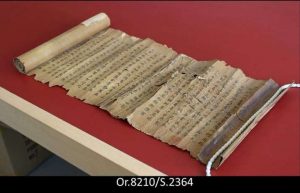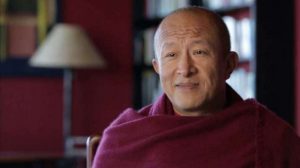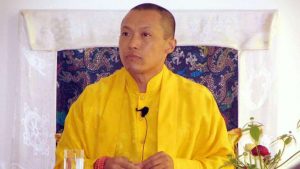
Unsullied, Like a Lotus in Mud, an exhibition which opened in March and runs until 16 June at the Hoam Art Museum in South Korea, sheds light on the representation of women in centuries-old Buddhist art from Korea, China, and Japan. The exhibition is aimed at highlighting the often-overlooked presence and contributions of women in East Asian Buddhist art, and features a number of masterworks with the help of art institutions from around the world.
“[The exhibition] will showcase the presence of women in the patronage and production of Buddhist art, while exploring the meaning of female images represented in Buddhist art,” the museum noted before the March opening. (The Korea Herald)
The museum, located in the city of Yongin in South Korea’s Gyeonggi Province, will host 92 paintings, statues, scriptures, and embroideries collected from 27 sources around the globe. More than half of the items have never been displayed in South Korea and come from New York’s Metropolitan Museum of Art, the British Museum, Tokyo National Museum, and the National Museum of Korea.
Additionally, the show will feature a 28-centimeter-tall, seventh-century gilt-bronze standing statue of Avalokiteshvara dated to Korea’s Baekje Kingdom (18 BCE–660 CE). The sculpture was last in Korea in 1929, when it was sold to a collector and taken to Japan. The cultural Heritage Administration of Korea tried to repatriate the statue in 2018, raising some 4.2 billion won (US$3.05 million), but falling short of the seller’s 15 billion won (US$10.9 million) asking price.

In Buddhist texts and art, women often played a supporting role. Queen Maya is best known for giving birth to Siddhartha Gautama, Mahaprajapati for taking care of him—she would later be the first woman ordained by the Buddha—and Yasodhara is remembered as his grieving wife and mother to his son, Rahula. Sujata, who offered the Buddha food after his most strenuous fasting, is honored today with a small village in her name near Bodh Gaya, India.
There is a set of texts devoted to the sayings of elder women, the Therigatha, but these make up just a small part of the early Buddhist corpus. In art, it is even rarer to find depictions focusing on women.
“In ancient Buddhist paintings, our attention is often drawn to the splendid figures of the Buddha and bodhisattvas, shimmering in gold, exuding delicacy and dignity,” the show’s curator, Lee Seung-hye, explained in a recent press preview at the museum. “However, this show aims to highlight the presence of countless women beyond that golden brilliance.” (The Korea Times)

Scholars note that the ordination of Mahaprajapati as a nun was a watershed moment for women in religion. However, the Pali texts describe the Buddha being hesitant when first asked to ordain women, and a number of additional rules were subsequently set out for them. As Buddhism spread throughout Asia, many notable women joined the sangha. However, they repeatedly faced challenges in being treated equally with their male counterparts.
One of the most notable women in East Asian Buddhism is the bodhisattva of compassion, Avalokitesvara. Early in Buddhist history, Avalokitesvara appeared in male form, but slowly took on a female appearance in East Asian depictions. Prof. Cathryn Bailey, who teaches gender and women’s studies at Western Michigan University, clarifies:
. . . it is not even quite correct to conclude simply that Kuan Yin was a male and is now a female, for they continue to be depicted as both. To further complicate things, they are often described as having an androgynous or “asexual’’ appearance. In short, although, for many, Kuan Yin is experienced simply as female, a glimpse at their story quickly explodes our familiar sex/gender categories. In short, they are a quintessentially trans icon in the queerest sense.
(Embodied Philosophy)
Additionally, the new exhibition highlights the significant role of women as patrons and artisans of Buddhist art. Women commissioned illustrated manuscripts, paintings, and sculptures, contributing to the flourishing of Buddhist art despite societal constraints.
Notable patrons of Buddhist art included queens, consorts, and members of the royal court, even during periods when Buddhism was officially suppressed. Their patronage was often seen as offerings for the king’s longevity and for the birth of sons.
One unknown noblewoman from Korea’s Goryeo period (918–1392) inscribed on a manuscript she commissioned: “For my past life’s misfortunes, I have been reborn as a woman. . . . Therefore, with the deepest sincerity, I earnestly wished to create one copy of the Avatamsaka Sutra written in silver and one copy of the Lotus Sutra written in gold.” (The Korea Times)
The exhibition also showcases magnificent paintings commissioned by Queen Munjeong (1501–65) of the Joseon Kingdom, as well as intricate textiles and embroideries created by unnamed female artisans.
Overall, the exhibition provides a meaningful exploration of the legacy of women in Buddhist art, offering a visual feast for visitors to appreciate and celebrate.
Unsullied, Like a Lotus in Mud will run at the Hoam Art Museum until 16 June. A free shuttle service is available to transport visitors between the Leeum Museum of Art in Seoul and the Hoam Art Museum.
See more
What to expect in Korean art scene this year (The Korean Herald)
For first time, exhibition sheds light on women’s roles in East Asian Buddhist art (The Korea Times)
How women have played a vital role in Buddhist art shown in landmark new exhibition in South Korea (South China Morning Post)
Embracing the Trans Bodhisattva, Kuan Yin (Embodied Philosophy)
Related news reports from BDG
Monks in Korea Welcome the Return of Buddhist Relics after 85 Years in US Museum
Korean Expert on Hand-Copied Buddhist Texts Visits Yale with Extensive Exhibition
Rubin Museum of Art, Known for Featuring Buddhist Art and Culture, to Close Its Physical Space This Year
Freer and Sackler Galleries Launch Digital Catalogue of Goryeo Buddhist Art
Goryeo Kingdom Exhibition in Seoul Celebrates Korea’s Buddhist History
Related features from BDG
Daughters of the Buddha: Unmun-sa, a Wellspring of Bhikshuni Ordination in South Korea, Part Two
Daughters of the Buddha: Unmun-sa, a Wellspring of Bhikshuni Ordination in South Korea, Part One
A Journey of Art and Devotion to Tara with Dr. Sarika Singh and Master Locho
Guanyin and the Filial Parrot: An Emperor’s Golden Offering
Convergence and Harmony: On the Schools of Chinese Buddhism
The Many Forms of Avalokiteshvara














